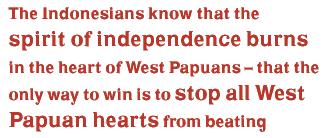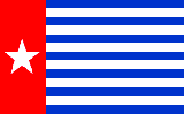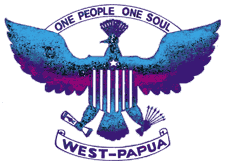He is being buried at the local football ground only a few hundred metres from West Papua’s main airport runway. Twenty thousand have come to watch. They fill the football ground and spill into the streets. Those who’ve climbed on to the sloped iron roofs of the surrounding buildings stand to salute, if they can, when the Papuan National Anthem is played. Everyone else stands sweating silently in the summer swelter of a West Papuan morning, through speech after political speech. It is not until the University Choir begins singing that they relax, sit down and start to talk with one another. The choir sings well, but this is not what the crowd has come to hear. They want to hear about independence and to say farewell to the man who was its figurehead: pro-independence leader Theys Eluay.
No-one yet knows for certain how Theys Eluay died. His body was found the morning after he attended a dinner to observe National Heroes’ Day at the headquarters of Kopassus, Indonesia’s élite army troop, in West Papua’s capital, Jayapura. The last time that the only likely witness – Eluay’s driver, Ari Masoka – was heard of, he was being held in Kopassus custody. Except for a small cut near Eluay’s left eyebrow and a drop of dried blood in his left nostril, his body bore no other obvious signs of trauma. An autopsy report dated four days after the dinner says that Eluay died suspiciously, due to suffocation and swelling. Much stronger conclusions were reached by the Institute for Human Rights Study and Advocacy. Its report says that Eluay was abducted, tortured and assassinated in a premeditated and politically driven act of public terrorism, and falls just short of blaming the military and police for the killing. The report also makes clear that the death is part of a broad strategy by the Indonesian Government to head off the West Papuan independence movement and the activists fighting for it. West Papuans know this without needing a report. It has been their reality for nearly 40 years – ever since their right to self-determination was shoved to one side and their country handed to Indonesia. That is why the football field where Theys Eluay is buried – at Sentani, 36 kilometers west of Jayapura – has been offered as a resting place to those who will undoubtedly follow him, dying in the struggle for independence.
Theys Hijo Eluay makes an unlikely hero of independence. He served for more than 15 years as a member of the Indonesian Parliament in the Golkar Party of President Suharto – whose government brutally suppressed West Papua’s independence movement. Theys Eluay’s support amongst the highland tribes was low. A leader of the highland community of Wamena tells me how, between 1961 and 1969, Theys Eluay personally requested the killing near Jayapura of 20 West Papuans who advocated independence. And in 1969 he was one of the 1,025 leaders who voted to incorporate West Papua into Indonesia (described on page 22). This sham vote – overseen by the United Nations – still enrages nearly every West Papuan I talk with. Thirty years later, in the towns and cities around the coast where the majority of Papuans live, all is forgiven. In just three years Eluay brought together all groups fighting for independence to speak with one united voice through the Papua Council: the organization he helped form, then led. Now, high-school student Fransisca Homer tells me, he is a hero: the inspiration for the West Papuan nation – the inspiration for freedom.
 Fransisca and I are standing watching the funeral procession that now moves down the main street of small-town Sentani. The crowd has just finished singing ‘Onward Christian soldiers, marching as to war’, one of the more feisty Christian hymns from West Papua’s missionary past. Many are waving the banned West Papuan flag – the red, blue and white Morning Star. Hundreds walk along the passage made by people lining the main street, carrying huge floral tributes. Fresh flowers are scarce. Huge artificial ones – made of paper and plastic – prove droop-free in the heat. They make up the purple and pink, the blue, yellow, green and white arrangements that are splashed on to large circles and hearts, with farewell messages written in the middle. The one from Indonesia’s former President, Abdurrahman Wahid, leads the procession. It says (in Indonesian): ‘Please accept my condolences on the death of Father Theys Hijo Eluay.’ It is this sign of respect and recognition from Indonesia that West Papuans had hoped would be paid by current President, Megawati Sukarnoputri. It does not arrive. This is not surprising. When he was President, Wahid acknowledged West Papua’s case to participate in governing its own resources, people and politics. He helped fund the Congress from which a united West Papuan independence movement – the Papua Council – emerged. By contrast, Megawati shows much less sympathy. While she has granted West Papua limited autonomy, she now talks of taking it away. Her government’s response to secession has been to move in more troops. Pursuing the vision of her father, founding President Sukarno, Indonesia, with West Papua, will be One Nation.
Fransisca and I are standing watching the funeral procession that now moves down the main street of small-town Sentani. The crowd has just finished singing ‘Onward Christian soldiers, marching as to war’, one of the more feisty Christian hymns from West Papua’s missionary past. Many are waving the banned West Papuan flag – the red, blue and white Morning Star. Hundreds walk along the passage made by people lining the main street, carrying huge floral tributes. Fresh flowers are scarce. Huge artificial ones – made of paper and plastic – prove droop-free in the heat. They make up the purple and pink, the blue, yellow, green and white arrangements that are splashed on to large circles and hearts, with farewell messages written in the middle. The one from Indonesia’s former President, Abdurrahman Wahid, leads the procession. It says (in Indonesian): ‘Please accept my condolences on the death of Father Theys Hijo Eluay.’ It is this sign of respect and recognition from Indonesia that West Papuans had hoped would be paid by current President, Megawati Sukarnoputri. It does not arrive. This is not surprising. When he was President, Wahid acknowledged West Papua’s case to participate in governing its own resources, people and politics. He helped fund the Congress from which a united West Papuan independence movement – the Papua Council – emerged. By contrast, Megawati shows much less sympathy. While she has granted West Papua limited autonomy, she now talks of taking it away. Her government’s response to secession has been to move in more troops. Pursuing the vision of her father, founding President Sukarno, Indonesia, with West Papua, will be One Nation.
This is my first morning in West Papua. I’ve come here to report on how a suppressed country is shaking off its shackles, and preparing its leaders for the challenges of governing a new nation. I’ve chosen West Papua because its situation is especially challenging. Eighty countries have become independent since the UN was formed in 1945. There are still 17 colonial territories on the UN’s Decolonization list queuing up for independence. But West Papua is not one of them. As far as the UN is concerned, West Papua lost its right to self-determination in 1969. At this moment, it cannot expect UN help to become independent.
At first glance, President Megawati would not have been displeased by what’s happening on the streets of Sentani today. The country is known worldwide as Irian Jaya, a province of Indonesia. All the speeches praising independence and its dead hero are spoken in Indonesian. Culturally, too, West Papua seems firmly placed within Indonesian borders. TV sets show programmes and people that are evidently Asian. But then again, the West Papuans gathered here are quite different. Unlike Indonesians elsewhere, their skins are not light but dark; their hair is not sleek but wiry and curled. These people look Melanesian – South Pacific islanders – not Asian. And judging from the unity amongst the funeral crowd, Indonesia has already lost West Papua. Fransisca looks around. ‘They have come from everywhere,’ she says. ‘Just look at their faces.’ She points out people from Fak Fak and Manokwari, well over 500 kilometres to the east; from Timika in the southeast where the locals have fought the mining corporation Freeport MacMoRan for a just return from its huge mine; and from Wamena in the highlands – the heartland of the OPM (Organisasi Papua Merdeka) freedom movement. ‘We all belong to the OPM,’ she laughs.
|
|
Sure enough, in the weeks that follow, every West Papuan I meet claims allegiance to the OPM. Waitresses, students, academics, business executives, storeowners – all say that they belong to the OPM. I can’t work it out. I had thought that the OPM was a small and secret band of freedom fighters based deep in the highlands, who emerged sporadically in violent protest against either the Indonesian military or the companies that rob West Papua of its resources. All these people couldn’t possibly belong to the OPM. Only when I get to Kelila will I understand what they mean.
Galile wants me to visit the village of Kelila. He picks me up at six in the morning in the highland town of Wamena. We drive northwards in a truck without suspension across unmade roads for three hours to where the mountains touch the clouds. There is the village, nestled in lush vegetation with greener-than-green forest backdrops.
Galile learnt West Papuan history here, not from classrooms (where things Papuan are never taught) but from the stories that parents have to pass on to their children to keep their ancestry alive. Now 24, Galile tells me a story from before his birth that his father had told him. He wants me to see where it took place: an act of West Papuan resistance and the Indonesian’s infamous reply. In 1977, the Indonesian army arrived in Kelila in helicopters and on foot. They rounded up highland leaders from around the northern Wamena region, then lined them up along the grass runway of the local airstrip. One by one, they took each leader into a hut near the end of the runway and asked them whether they were with Indonesia or West Papua. Those who said West Papua were shot. Then their bodies were put in a pit and burnt.
No-one knows how many died. Reverend Obed Komba flew into Kelila that day and saw what happened. He puts the death toll at more than a hundred. For 12 years after the Kelila incident, he says, the military killed 10,000 more people around the Wamena region, many of whom were asked the same deadly question put to the people at Kelila.
Today the tourist guides will tell you that Kelila is an OPM stronghold. This is not because there are bands of the OPM liberation army hiding in the surrounding forests: there are no such bands there. It is because of the thousands who have died for refusing to give allegiance to Indonesia, and the thousands more who are prepared to die calling themselves West Papuans. Says Obed Komba: ‘We black men are all OPM. In the cities we talk. In the forests, some fight. But being OPM is in the heart – it is about being West Papuan and wanting independence.’
 The Indonesians know that the spirit of independence burns in the heart of West Papuans. They know that this is the most potent enemy that they will have to fight – that the only way to win is to stop all West Papuan hearts from beating. In the last three years of his life, Theys Eluay proved that the spirit of independence burned in his heart too. On the day that he’s buried, this is what matters to the crowd. Past killings, past betrayals – they are no longer important. But when Eluay’s body is buried in the football ground, his heart is not. In an ultimate outrage, it has been removed by Indonesian authorities for a post mortem examination, and not returned in time for the burial.
The Indonesians know that the spirit of independence burns in the heart of West Papuans. They know that this is the most potent enemy that they will have to fight – that the only way to win is to stop all West Papuan hearts from beating. In the last three years of his life, Theys Eluay proved that the spirit of independence burned in his heart too. On the day that he’s buried, this is what matters to the crowd. Past killings, past betrayals – they are no longer important. But when Eluay’s body is buried in the football ground, his heart is not. In an ultimate outrage, it has been removed by Indonesian authorities for a post mortem examination, and not returned in time for the burial.
Like Theys, some voices are absent from the ceremony today: activists who are in exile or hiding. There are strong and powerful voices that fill the gap. But will they be strong enough to deliver freedom? Tom Beanal, who has replaced Theys Eluay as the leader of the Papua Council, promises the crowd a referendum, so that they can tell the world that they want independence. Willy Mandowen, one of the intellectual guides of the new independence movement, is behind the scenes ensuring that things run smoothly. So much is against them: a staunchly nationalistic Indonesian Government backed by thousands of murdering militia; insufficient time to build political and economic leadership amongst their people, so that they can take the reins of government; an international community determined to look the other way. How can they win against such obstacles?
But then, there is the funeral crowd – 20,000 West Papuans carrying the spirit of independence in their hearts. With such spirit and will, the fight for freedom is well on its way.

